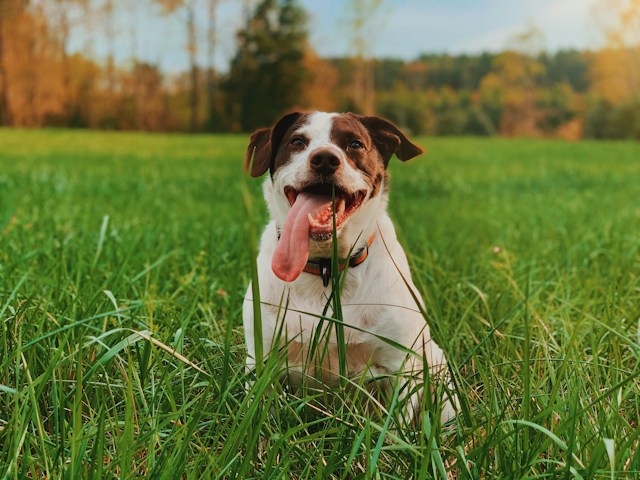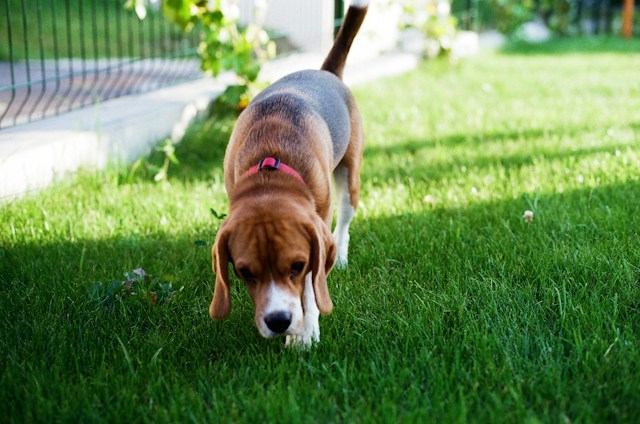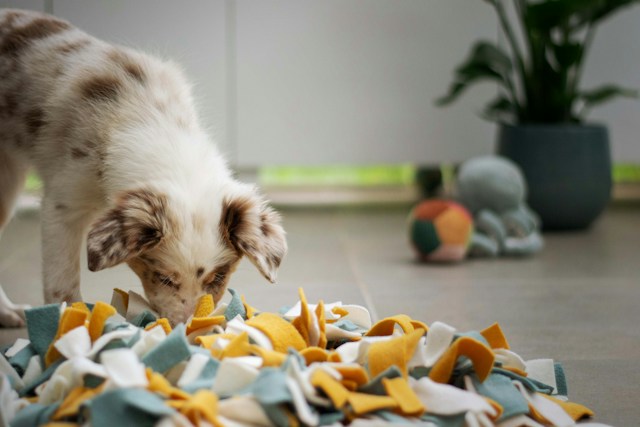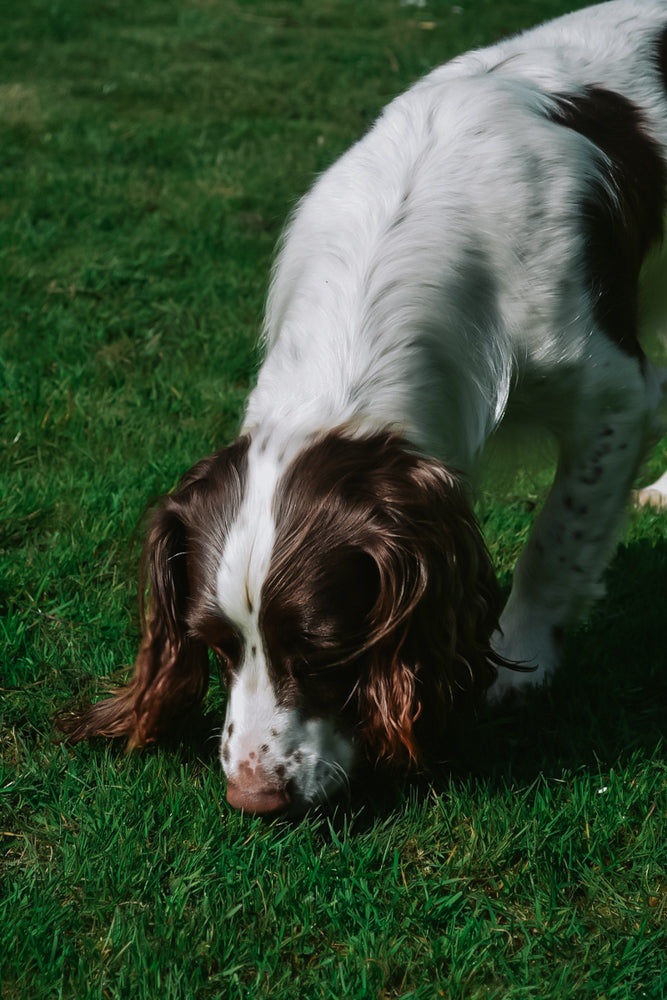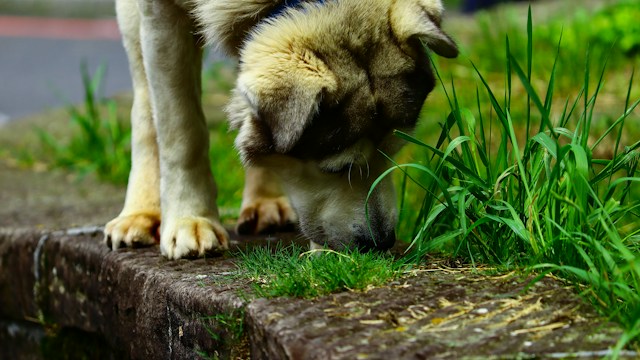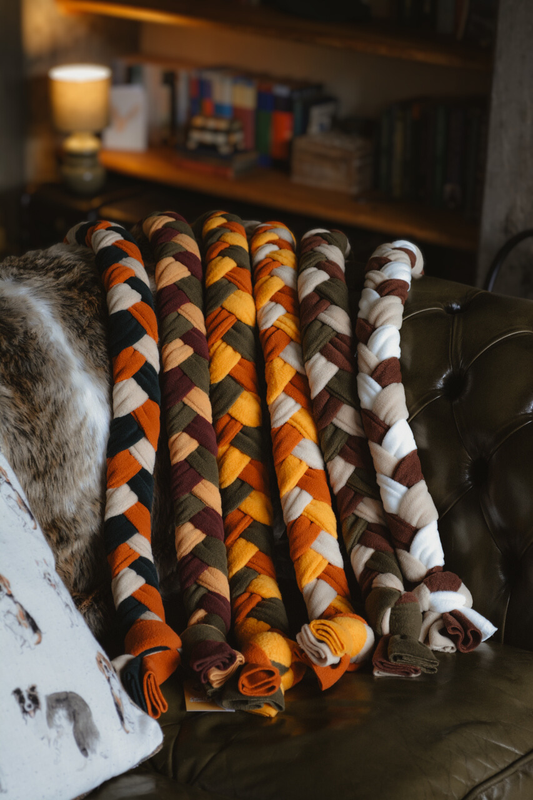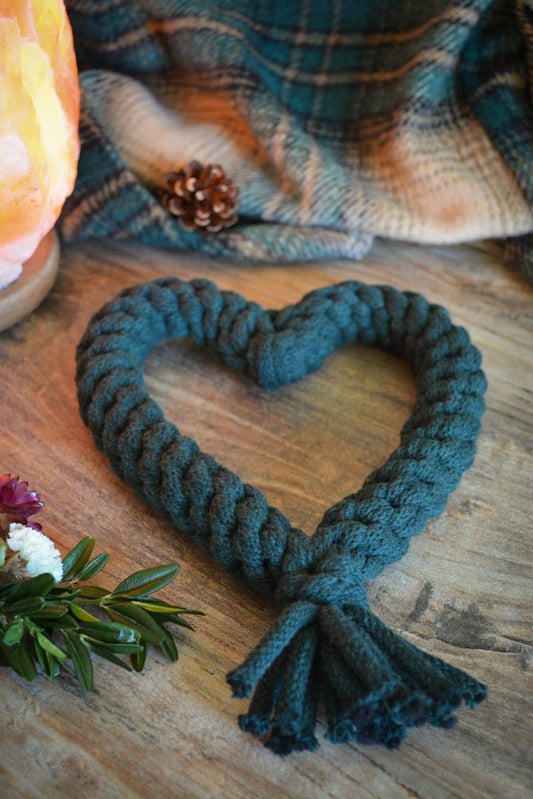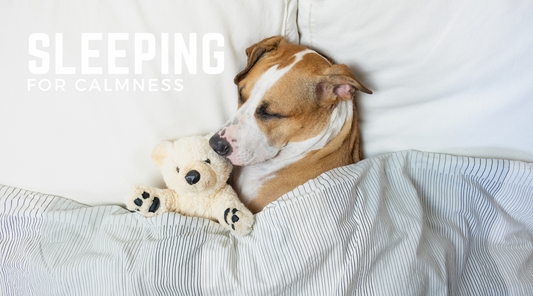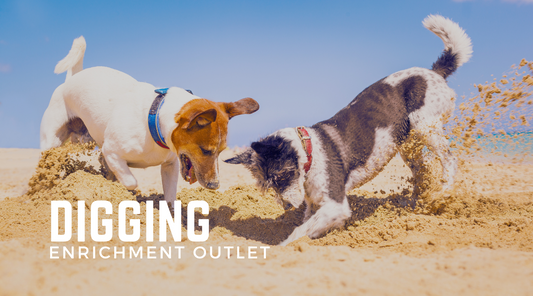Scatter Feeding Dogs: A Step-by-Step Guide To Our Favourite Calm Enrichment Activity!
You've heard about scatter feeding dogs but aren't quite sure what it's all about or whether it's the right enrichment activity for your dog? You're in the right place :) Let me get you all caught up.
Scatter feeding is a simple yet powerful tool that can help calm high-energy dogs, reduce stress and provide much-needed mental stimulation.
Whether you're looking to reduce arousal levels, boost confidence or find new ways to enrich their daily routine, this guide will give you everything you need to get started and make the most of scatter feeding as part of your dog's enrichment plan.
"Scatter feeding has been a life changer for us. It turns zoomies into something manageable, and sniffing tires him out like nothing else!"
"Such a calming video. Scatter feeding has been the single most effective strategy I have used and continue to use with my excitable springer. I look forward to watching your other videos for more ideas. Thank you."
"I have found scatter feeding works really well with my high energy lurcher. I had an operation a few weeks ago and this has proved invaluable and very popular in keeping him happy while I can't get out and about as much."
"We've started scatter feeding treats when our reactive malamute puppy fixates on other dogs on walks - double click on the clicker and cueing 'find it' brings his nose down for a little calm sniff and lets us avoid any big reactive moments! Very excited for more tips to help us help him be the best dog he can be!"
What is scatter feeding?
Scatter feeding dogs couldn't be easier!
This slow-feeding enrichment activity involves scattering your dog’s dry food across a grassy area for them to forage.
Think of a piglet with their snout to the ground, happily sniffing out truffles in the undergrowth!
Should enrichment activities be challenging?
Enrichment can absolutely be as simple as scatter feeding.
It's all about providing natural behavioural outlets - giving your dog the time and space to feel joyful, relaxed and fulfilled.
Enrichment is not about making your dog's life more complex or challenging (a common misconception).
When we talk about mental stimulation for dogs, I'll often see comments from people who disregard certain enrichment activities because they're "too simple" for their clever dog. Their dog will typically be a high-energy, working breed.
While mental stimulation can involve a whole array of brain games for dogs (as per the Enrichment Deck), what is key is to always qualify whether an enrichment activity is actually enriching.
We don't always need to increase the challenge level. Engaging the nose is mentally stimulating for dogs and the ease in which your dog can 'complete' the activity it's part of the benefit (we'll look more at the benefits below).
Plus, calm enrichment activities are often the antidote to over-aroused, high energy dogs that struggle to switch off. If a dog is over-aroused, they are in a state of stress regardless of whether that's positive eustress (i.e. chasing a ball) or negative stress (overwhelmed, anxious, chronically anything). A stressed dog doesn't need more challenge, they need more relaxation.
Lastly, life can be busy and overwhelming for us. It's why I created the Enrichment Deck in the first place - to reduce my own mental load. So get a cup of tea and just enjoy some low-key enrichment activities!
In a moment, we’ll look at the different ways you can scatter feed and how to adjust this activity to suit your particular dog.
…But first, it’s important to understand why scatter feeding is such a foundational pillar for enrichment.
What are the benefits of scatter feeding dogs?
As with all enrichment, the purpose is to add something positive and mentally stimulating to your dog’s day that fulfils a natural behaviour. So how does scatter feeding dogs do this?
-
Benefit 1: Provides mental stimulation
Mental stimulation is key to promoting calmness in dogs, especially those with active minds. Without enough mental engagement, dogs can become frustrated and overly aroused. Over time, this can lead to more serious behavioural issues. One of the easiest and most effective ways to provide mental stimulation is by encouraging your dog to sniff more. Sniffing is a dog's primary sense and the way they naturally explore the world. While much of dog training focuses on helping them fit into our human-centric world, enrichment is about allowing them to connect with their own world and simply be dogs. Sniffing is also incredibly calming - by engaging their brains through their nose, dogs become calmer, more relaxed and fulfilled. This mental exercise helps them sleep better, continuing the cycle of calmness.
-
Benefit 2: Fulfils natural behaviours
Sniffing and eating are fundamental behaviours. As dogs are natural scavengers, they can benefit from the dopamine release they receive while foraging. (We'll cover how to put a boundary on this behaviour to prevent unwanted scavenging.) Dopamine tells your dog that the activity is fun and rewarding. If we don’t mentally stimulate our dogs, they’ll may look elsewhere to get their dopamine hit. This can include running off to chase scents and/or wildlife, relentlessly playing with or pestering other dogs, chronic fixation on high dopamine games such as fetch and stealing or chewing your belongings. Lack of enrichment and mental stimulation will also have a major impact on your training - loose leash walking and recall will suffer. Giving your dog plenty of outlets for expressing natural behaviours is foundational to their mental wellbeing and they will feel more relaxed for it. These outlets can include sniffing, foraging, chewing etc. Meet your dogs needs first and any necessary training will become much easier to build upon this foundation.
-
Benefit 3: Boosts your dog’s confidence
The simplicity of scatter feeding is also beneficial – find the treat, eat the treat. This easy win helps boost your dog’s confidence and a confident dog is happier and less stressed. Higher levels of confidence help dogs cope with everyday life and as well as supporting them in making ‘better’ decisions, such as recalling from distractions and more balanced greetings and interactions.
-
Benefit 4: Calming & relaxing
As well as helping your dog’s mental wellbeing, enrichment activities that promote calm sniffing also lower the heart rate and slow everything down to a more relaxed level. Like us, dogs benefit from activating their ‘rest and digest’ system. Chronic stress can mean more time in ‘fight or flight’ mode, which hinders the dog's ability to think and respond in the way you expect. So if you find you are hitting a wall with your training, it could be that your dog is just too stressed to compute what you're asking. Dedicated relaxation time helps dogs to settle into a calmer baseline.
-
Benefit 5: An easy introduction to scentwork
Scatter feeding dogs is a good starting point, especially if they are get frustrated with more challenging puzzle toys. This easy introduction to enrichment activities is easy for the owner as well as being enjoyable and rewarding for the dog. It’s a win-win. Who knows, it may inspire you to try a scent class with your dog. but it's ok if scatter feeding on your lawn is as far as you take it!
-
Benefit 6: Provides a method of slow feeding
This slow-feeding activity helps to prolong meals. This is helpful for dogs that otherwise gulp their dinner and are most at risk of bloat (such as Great Danes, St. Bernards, Irish Wolfhounds, Boxers and other deep-chested, large breeds). Scatter feeding is an easy way to utilise some of your dog’s daily food or treats for enrichment.
What you will need
- Dry food or treats!
- A safe area to scatter the food.
A grass lawn works best for scatter feeding.
Since the purpose of this enrichment activity is calm sniffing, ensure the grass is long enough so that your dog is using their nose to find the food (rather than spotting each piece by sight).
If you have a small lawn, you may want to scatter a small portion of food at a time to extend the session duration.
My spaniel will happily scatter for 45 minutes, though you don't have to go for this long. I would aim for at least 20 minutes if you are wanting to provide a calming sniffing session.
Creating a Boundary
Place a boundary around scatter feeding by presenting it as a designated activity.
- Start by placing the food into a treat pouch or your dog's bowl. This helps create a visual association for food.
- Next, place a piece of food in the grass or snufflemat with the cue, "go snuffle".
- Once your dog has found this piece of food, they'll likely look up at you for more. Place another piece down and repeat the cue.
- You'll need to practise the cue multiple times over a number of sessions to embed the association.
- At the end of each session, show the empty bowl or pouch and say "all gone". Put the bowl/pouch away and resume your day.
"Leave" can be a very important cue to teach your dog. I don't want to make this post too long, but do look into how to teach your dog "leave" with positive reinforcement.
Safety considerations
Other dogs
Be mindful of your location when scatter feeding, and always do it well away from other dog walkers.
I’m able to do this easily because I live in a very rural area and can hike off the beaten track, but if you're limited to busier 'dog walking hotspots' or public spaces, it’s best not to scatter feed in these areas.
There’s a risk of other dogs competing for the food, which could lead to unwanted behaviour or stress.
Additionally, some dog owners may not want their dogs finding food in public spaces for various reasons such as behavioural concerns, dietary restrictions or health conditions like allergies to certain ingredients.
Sticking to your own lawn, private field hire or a snufflemat would be better alternatives.
Risk of bloat
It’s important to be aware of bloat. This is a dangerous condition for dogs that can be fatal.
Some breeds are more prone to bloat than others, typically large or deep-chested breeds such as Great Danes, St. Bernards, Weimaraners, etc.
Scatter feeding can help reduce the risk of bloat as it is a slow feeding approach, though high-intensity activity surrounding a meal may increase it.
As a general rule of thumb, I make sure my dog is fed at least 2 hours before going out for exercise, or that he waits at least 2 hours after exertion before eating.
For more vigorous exercise that causes panting, or if I had a breed prone to bloat, I would extend the waiting period even longer to ensure their safety and comfort.
This helps his body calm and cool down before eating a meal.
If you want to scatter feed in the countryside, ways to reduce the risk of bloat include:
- Going to an area where your dog is calm. (Cam is now very calm in our local woods as we regularly scatter feed there.)
- Going during a cooler period of the day, so your dog is not panting from the heat while eating.
- Having your dog on a long line can reduce the intensity and distance they run.
- Going somewhere specifically to scatter feed and then come home. You can do a ‘walk’ separately at a later time.
- Picking a quiet spot where you’re unlikely to be disturbed by other dogs as this may cause your dog stress while eating (it’s also not good for other dogs to be eating your dog food in case they have allergies so choose your spot mindfully).
- Using a portion of their meal to scatter instead of the whole meal.
- Increasing the size of your scatter area to slow down eating.
Separate toilet area
If you have a small lawn that your dog uses daily as a toilet, it's best to scatter feed in a different area.
Consider using a front lawn to scatter feed, if you have one, or other green space.
You can always keep your dog on a long leash while they do the activity.
Alternatively, if you're able to take your dog on walks or short trips to toilet, you can reserve the main lawn for scatter feeding.
Pesticides
Avoid scatter feeding on grass that has been sprayed with any chemicals or pesticides.
Not all lawn products are pet-safe, so always double check.
Slug/snail parasites + poisonous plants & wildlife
Be aware of poisonous plants, such as ivy, foxgloves, daffodils, crocus, etc.
Google "poisonous plants for dogs in [your country]" to familiarise yourself with these.
Also, avoid scatter feeding in areas that have acorns and conkers. These can be extremely toxic if consumed.
Lungworm is a serious condition caused by a parasite carried by slugs and snails, so it's important to check your lawn for these as well as their slimy trails.
If your lawn is overrun with slugs and snails, it's best to avoid scattering food for your dog.
Slugs and snails are most active during the warmer months, especially overnight after rainfall, so be extra vigilant during these times.
If you live in an area with poisonous creatures, such as snakes, spiders and scorpions, make sure to check any long grass thoroughly before scatter feeding your dog.
Flat-faced breeds (protruding eyes)
If you have a flat-faced dog, ensure the grass is free from any rocks, sticks, etc that could damage their protruding eyes while snuffling through the grass.
Scavenging: Should food be on the floor?
Some people will teach their dog to never pick anything up from the floor, in which case, scatter feeding is probably not a good fit. A snufflemat could be an option though.
Scatter feeding doesn't mean a scavenging free-for-all and my dog doesn't counter surf, raid bins or beg while we eat. That doesn't mean you can't inadvertently encourage unwanted behaviour, hence why I'm doing my best to cover this topic as thoroughly as I can.
I use the ground a lot in training. Here are a few examples:
- Bowling single pieces of food along the ground to create moments of fun and engagement (chase/catch).
- Placing a piece next to my foot to develop the heel position.
- Placing a piece of (unexciting) food down next to my dog when he's calmly settling, to encourage this behaviour.
- Scattering food on the ground to bring the energy down if he's being bouncy (four paws on the ground please). This can help to direct attention away from guests.
- Chucking a single treat into the grass for a quick game of 'find it".
It’s important to look at the bigger picture when it comes to your dog’s overall wellbeing.
If your dog has enough appropriate outlets for their physical, mental and emotional needs, they are far less likely to engage in unwanted behaviors or seek out their own forms of entertainment - such as stealing, destructive chewing or scavenging.
Providing a balance of exercise, mental stimulation, enrichment activities like scatter feeding, and rest helps keep your dog fulfilled and content, reducing the likelihood of boredom-driven mischief.
However, if your dog is prone to indiscriminate scavenging or scavenging is a concern for you, it may be best to avoid this activity. Any problematic behaviour is best discussed with a qualified behaviourist.
As with any enrichment activity, it’s important to use your own judgment based on your dog's behaviour, environment and needs.
If you're concerned about safety or distractions, stick to a snufflemat or your own lawn or private field hire if it fits within your budget (so long as your dog reliably hoovers up all the food).
Private field hire can provide a controlled, safe space for your dog to enjoy outdoor enrichment activities without interruption.
How scatter feeding can help reduce overarousal
We don’t need to physically exhaust our dogs to achieve a calm household.
Scatter feeding can be a useful low-arousal activity for dogs that could do with more calmness in their life.
My spaniel is much calmer from mental stimulation, enrichment and brain games than high-energy romps through the countryside!
My motto is: "A calm dog is a happy dog." (Rather than the usual, "A tired dog is a happy dog.)
He still has plenty of time off-lead as sniffing and exploring interesting environments is the most enriching part of his day. I just use scatter feeding as a tool to help him adjust to new environments, reduce his arousal levels and create a calmer experience.
If you have a high-energy dog, such as a working breed, mental stimulation through scatter feeding may well be your new best friend.
Our scatter feeding journey
I scatter feed multiple times throughout the week. While Cam always gets excited about his scatter feed, and will wag his entire bottom enthusiastically (that's part of his core personality), engaging his nose and brain for a sustained period helps to balance out his high drive, physical energy and arousal levels.
This is because sniffing is calming, whereas racing around in 'hunting mode' increases arousal levels.
…But don’t spaniels race around while sniffing? Isn't that what they're born to do?
Well, yes, they are breed to flush, search and retrieve and so running and sniffing is often all-in-one. If you, too, have a spaniel from a long line of field trial champs, you will know how incredibly driven, single-minded and excitable they can be!
However, it's important to note the difference between a working breed in a companion home verses an actual working dog.
A working dog will train and work for longer periods than most of us companion 'owners' want to commit.
Companion dogs need an outlet for that working drive, and an alternative way to interact with the environment.
This can include dummy retrieval or search games. These activities will naturally be higher arousal than scatter feeding, which is fine. Arousal isn't the enemy. We just have to manage it.
So while spaniels live life at a faster pace, I have discovered Cam is not one-speed. He does indeed have a slower pace that I call the “mooch”. This is when he (still) runs but does so in a leisurely, relaxed manner taking in calm sniffs. He’s essentially trotting about ‘smelling the roses’.
For me, this mooch is the holy grail; he’ll benefit from those mentally stimulating sniffs without racing around hunting the wildlife.
Many spaniel owners struggle with out-of-control hunting behaviours, so it is an important topic to address.
This isn't just a training issue - it also has a wider impact on the environment. With limited natural spaces left for wildlife, off-lead dogs can unintentionally disturb or stress local ecosystems. Finding a balance between allowing dogs to express their instincts in a controlled way (through structured enrichment activities like scatter feeding) and respecting wildlife is crucial for responsible dog ownership.
For dogs who ‘lose their minds’ as soon as they get outside, scatter feeding is a productive way to create some focus and structure. Organised fun, if you will.
The more you scatter feed, the more settled into the activity your dog can become.
Through scatter feeding, Cam’s movements became slower, calmer and more relaxed. So I piggybacked on this in the great outdoors.
Here’s what I did…
I introduced scatter feeding in new environments gradually because we were working on lowering excitement levels. When a dog is overstimulated or over their threshold, they often won’t be interested in food. This makes food engagement a useful gauge of their emotional state - if they’re too aroused to eat, it’s a sign that the environment may be too overwhelming. In that case, it’s best to take a step back and work in an easier setting before progressing again. By carefully adjusting the level of challenge, you can help your dog build focus, confidence and calmness in different environments over time.
Please note that if you have a nervous dog, this may not be appropriate. Let them eat their food where they feel safe and focus on building their overall confidence levels.
Step 1: Scatter feeding the garden.
While the garden has more interesting scents than inside the house, familiarity can breed calmness since there’s no real novelty if your dog is used to being in the garden. So the garden is a good place to start.
It’s also where your dog will likely feel most at ease, which is important, otherwise they won’t be interested in eating.
If you have a small lawn, you could break up their meal into portions. This way your dog will be working their nose more as there is less food to find over the space.
Once they have found all of the food, you can go ahead and scatter the next portion to extend the sniffing session.
Step 2: Scattering on the front lawn.
Once Cam was into a good rhythm of scatter feeding in the garden, I decided to try this at the front of the house.
Just stepping outside the front door was hugely stimulating for him, with all of the sights, sounds and smells rushing in (even within a very quiet area).
So I started by putting on his harness and leash (which can be an excitement trigger for some dogs) and going out to our front lawn to scatter feed.
This helps add an element of calmness to wearing a harness and leash, as opposed to these items always signifying an exciting walk.
If you don’t have a front lawn, you could use a snuffle toy - the Puzzle Plait is a customer favourite.
Step 3: Scatter feeding in fields.
I then began scatter feeding in the field at the bottom of our garden.
Obviously you will need to get permission (and check what the field is used for - avoid scatter feeding if the ground is sprayed with pesticides/chemicals) or, if it's a open access land, be well away from other dog walkers. I always make sure we’re alone when scatter feeding as I don’t want him to be surprised by other dogs or have dogs eat food that may not agree with them (so always be mindful of this when scatter feeding outside). Private field hire is another option.
This was perfect as it meant I could scatter across a much wider area and the grass was far longer than our lawn which gave him a more intensive snuffle session (30-45 minutes).
It is important to note that bloat (a dangerous condition – see more on that above) can occur if a dog exercises on a full stomach.
So at first, I had him on a long line to ensure he wouldn't be running around the whole field. Once he got accustomed to going out to scatter feed, I could have off-lead.
As soon as he finished finding all the food, he’d hop over the dry stone wall and back into the garden of his own accord. Partly because he was ready for a drink after eating, but it was still positive that he would choose to come home for a sleep on the sofa over the allure of the countryside.
Step 4: Scatter feeding in the woods.
Bit by bit, we gradually expanded our scatter feeding sessions to our local green spaces.
Again, you will need to determine that the space is safe to scatter feed. In the summer, I do an adder check! You also want to avoid any plants that may be poisonous, as well as areas that have conkers or acorns. It's also important putting down food that could be eaten by another dog, so be mindful where you scatter. I'm often out at 5am during the summer months so we don't see anyone else in my rural area.
Now, he is calm enough in our local woods to scatter feed off-lead before continuing for a calm walk. It's been a revolution! Never did I imagine he could be that calm in the woods.
It trurly pays to take the time to set the tone of your walks.
If your dog is getting hyped up just putting on their harness on, then they're squealing with excitement in the car before tsking off like a rocket as soon as their let of the lead... The arousal level is so high that it's setting yourself up for a stressful time.
Now, even if I don’t scatter feed in these areas, he’s so much calmer as a default. This has increased sniffing and decreased racing around.
When he’s in this ‘rest and digest’ mode, he’s not that interested in birds and is much more responsive – because his brain is calmer it can process what I am trying to communicate.
If a dog is over-aroused, they are more in a state of ‘fight or flight’.
Whether it’s through excitement or anxiety, they are over the threshold and therefore they have little interest or mental ability to do tricks or take treats from you. They’re just not in the right headspace.
This is why scatter feeding can help redress the balance since you’re feeding into calmness and confidence.
Don't get me wrong - he's a spaniel. Prey animals like rabbits, hares and even deer very much excite him, and given the chance, he’d love to chase. However, these incidents have less likely because he’s not constantly in ‘hunt mode,’ actively seeking out wildlife. His recall is also spot on, even when he’s aroused, and a big part of that comes from maintaining a calmer overall baseline. When he does spot a deer, his brain is still able to process my recall cue rather than being completely overwhelmed by instinct. That said, I always keep him on a lead around livestock and during bird nesting season to ensure we respect the environment and wildlife.
As with all dogs, it's about meeting them in the moment and this is ever changing.
I notice that times when I'm in a rush or feeling stressed, he'll match me and be whirlwind. So it's never 100% calm in every situation. He gets excited about new environments and going out on big hikes, so I still need to manage his arousal levels. That's part of having a spaniel; they are fun magnets, thrill seekers and opportunists - and I don't want to extract his personality.
Sometimes he’ll get accosted by another dog while on his walk or he will find a football in the brambles and his adrenaline levels will surge.
If that happens to you, don’t feel like the walk is a failure and a write-off. These things happen and are often out of our control.
What you can do is help your dog recover emotionally. Again, this is where scatter feeding can come in.
Once he is home after a high arousal experience, and has physically settled down (at least 2 hours post-walk is my general rule), I scatter feed on the lawn to help him get those much-needed calm sniffs. Then let him sleep undisturbed!
FAQ
Who can benefit from scatter feeding?
Enriching your dog’s life needn’t be complicated or time-consuming. Scatter feeding is so easy to do. It’s the perfect activity for those days when your head feels overly full or your energy is limited.
As I sometimes get chronic pain flare-ups; scatter feeding (“Hunter Gatherer” card in the enrichment deck) is my go-to activity when I need to give my spaniel a sustained sniffing session without walking miles.
Does your dog typically spend much of their walk racing around? Perhaps wanting to play fetch or chase with other dogs? If so, they may be over-aroused and in need of some calmness in their day.
Scatter feeding can help encourage your dog to slow down and sniff more.
Time spent sniffing interesting smells in the countryside is what a dog walk is all about for your dog.
Sniffing is beneficial for all dogs, helping them to relax and feel calmer, while also being the most mentally stimulating activity they can do!
After all, smell is a dog’s most prominent sense and so sniffing is how dogs explore the world.
If you have a super-sniffer breed, such as a spaniel or bloodhound, activities that involve nosework are a double bonus as they provide breed-specific enrichment.
What food is best for scatter feeding?
Scatter feeding is best done with dry food. If you raw feed and want to do scatter feeding, consider cold-pressed as an option.
You can also scatter feed with small chunks of fresh food such as cucumber, sweet potato, etc.
Dry treats can also be used, though I’d recommend scattering these across a wider area so your dog has to sniff more for those higher-calorie treats. Treats are usually more motivating than your dog's daily dry food, so you can use less treats than you would their food.
Deep belly sniffing is quite the workout for your dog, so could offset additional food.
However, you will need to figure out what’s best for your dog. My spaniel is very active so bonus food and treats aren’t an issue, however, I do typically scatter with a portion of his daily dinner.
Where is best to scatter feed?
A grassy patch is the best area to scatter feed.
Ideally, grass should at least be a couple of inches long to ensure that your dog is seeking the food using their nose rather than their eyes. This is important!
You can scatter feed on a short lawn as a slow-feeding activity, but it won’t provide the same amount of mental stimulation and have the same calming effect as a true sniffing session.
My spaniel typically spends at least 20 minutes foraging his food – I would aim for this as the minimum. Generally, I aim for 30-45 minutes. Experiment with the size of the area you scatter across.
The bigger the area, the longer it will take your dog to find the food.
If you have an active, high-energy dog, and they are finished in 5-10 minutes, try widening your scatter radius.
How often should we scatter feed our dog?
Foraging is a natural behaviour for dogs so it’s not necessarily something they will get ‘bored’ of – my spaniel has a very happy tail when he’s scatter feeding. He loves it. Never has he turned his nose up!
…But all dogs are different and some may be less interested or motivated to scatter feed and that’s ok.
The enrichment deck has 52 different activities so there may be something your dog prefers to do more often, so go based on what makes them happy!
If your dog seems uninterested in scatter feeding at first, persevere and see if you can encourage them. You can drop in some treats here and there to help increase motivation levels and get them started.
Or, they may be too anxious to scatter in the great outdoors and so you can use a snuffle toy or scatter in your garden where they feel safe.
While it can be beneficial to provide lots of scatter feeding opportunities for your dog throughout each week, variety is also a key component of enrichment. That’s why I created the enrichment deck, so I’m not doing the same couple of activities over and over.
So I personally don’t scatter feed every single meal, but I know some people do and swear by it!
If my dog has been on a long hike with me and is hungry, he has his food in a bowl.
Otherwise, I mix in other games and activities with his food.
Are there any disadvantages of scatter feeding?
Every dog is different and so there are always considerations. It’s important to note that scatter feeding may not be suited to certain dogs.
You may have heard of the term “Ditch the bowl” – intended as a positive movement to encourage dog owners to create more enrichment from their dog’s daily food allocation.
However, a predictable, non-challenging feeding routine is important for some dogs. We need to consider every dog as an individual and adapt to suit them.
Also, see the section further up the page on "safety considerations". This includes information on indescriminate scavenging, which can be an issue with some dogs.
What dogs may not be suited to scatter feeding?
- Shy, nervous and anxious dogs may feel better about consuming their food in a predictable and unchallenging routine (a bowl).
- Dogs in a new home or environment take time to settle in and adjust. If they are uncertain about their surroundings they may feel uncomfortable snuffling for their food.
- Those with unknown, challenging or rescue backgrounds (please discuss scatter feeding and other brain games with your rescue centre or behaviourist).
- Dogs who are prone to eating anything and everything likely don’t need further scavenging reinforcement through scatter feeding. It’s an issue that would be best addressed first with a behaviourist.
This is not to say scatter feeding can’t be a positive and calming enrichment activity for these dogs. Just a few notes to consider! It may come down to timing. It’s best to introduce any new enrichment activities when your dog is feeling happy, confident and secure. This helps to create a positive experience.
Can I adjust scatter feeding?
Yes, always look at your circumstances and adjust to suit you and your dog.
The Enrichment Deck provides lots of enrichment activity ideas to engage your dog's mind and nose.
Can I scatter feed if my dog is raw fed?
Scatter feeding is best done with dry food.
You could look into cold-pressed food, which is more minimally processed and retains the nutrients better than kibble. I use a handful of this here and there during the week to scatter feed.
Many different natural, grain-free treats are available.
Training treats are particularly good for scatter feeding as their small size goes further. You could also break up pieces of air dried treats to use.
Enrichment can also come in the form of food variety. Add in different food items for extra enrichment. This could include small chunks of other dog-safe food such as cucumber, cooked sweet potato, pieces of boiled egg, scraps of meat, etc.
I use a combination of all of these and factor it into my dog's overall food intake.
What if my dog is nervous outside?
It's best to scatter feed in an area where your dog feels safe. A snuffle toy would be a good indoor alternative.
What if my dog is prone to eating things they shouldn't?
If you have a scavenging problem with your dog, it's best to avoid scatter feeding, or at least discuss this with a qualified behaviourist first.
They can help you with your dog so that perhaps scatter feeding is something that can be beneficial in the future. But right now, focus on getting on top of that concern.
Possibilities could include creating a boundary by including a “go snuffle” cue along with a designated snuffle toy.
However, if you dog also eats non-edible items, such as socks, then don't use snuffle toys.
Or, if your dog chews all their toys, scatter feeding on the grass would be the better option over snuffle toys.
You can train your dog to snuffle instead of chew. See: How To Introduce Snuffle Toys
If your dog struggles to snuffle, you may find that a large, heavy-bottomed (rubber) snuffle mat is helpful.
While large dog can pick up a snuffle mat, it’s much harder to do so than a smaller and lighter snuffle ball that they can shake.
Always supervise your dog with snuffle toys and safely remove if they try to chew them.
If they are always trying to chew, look into providing more appropriate edible chews, such as raw bones.
Once they have a healthy outlet for chewing, you may find they become far less interested in chewing their toys or your items!
Can I scatter feed with multiple dogs?
Many dogs will happily scatter feed together, however this is not always the case!
As ever, it's individual. If you are questioning this, there's likely a reason. So best trust your gut and conduct enrichment activities separately if you think there could be conflict with food aggression and resource guarding.
My dog is stressed, anxious or in a new home.
Consider timing; is now the right time for enrichment activities or do they need more time to settle in and feel safe in their surroundings?
If you think scatter feeding or other brain games and enrichment activities would be beneficial, you could do it with a treat allocation.
This way, it’s an optional activity with extra rewarding treats rather than them having to engage to fulfil hunger.
Ensure they can receive their main food within a predictable routine and without being challenged.
My dog chases light and shadows, would scatter feeding help?
Light or shadow chasing can be the result of highly active brains, anxiety, frustration, pain, Obsessive Compulsive Disorder, or lack of physical and mental stimulation.
If your dog is a shadow/light chaser, it would be best to consult with a vet or qualified behaviourist. They can assess your dog for pain and OCD.
If the shadow/chasing is due to boredom and lack of mental stimulation, then scatter feeding could be extremely beneficial.
Not only is it a mentally stimulating yet calming activity, it directs the focus away from the eyes and engages the nose.
Increasing mental stimulation through brain games and relieving frustration through easy enrichment (such as chewing) can help dogs overcome this.
Again, seeking qualified help will be the quickest route to identifying the cause and helping to resolve it as it can be a challenging issue.
I want to try scatter feeding but dog won't accept food outside.
If your dog is confident, just uninterested, you could try using food that is more appealing to them or pointing it out. Some dogs need extra guidance when getting started - encourage your dog and show them that hidden treats await.
Not all dogs are 'super sniffers', so scatter feeding may not be their top choice activity so think about what your individual dog finds enriching.
Dogs who get overstimulated outdoors are sometimes chronically under-stimulated. (I.e. They feel bored at home and their walk is the only highlight of the day.) This creates a great deal of excitement around the outdoors. So more frequent outings could help them, along with brain games and enrichment.
Sometimes we’ll do a sniffy loose leash walk to a grassy area, scatter feed and then walk home. This serves as a short but fulfilling outing.
Please note that you should find a quiet area away from other dogs to prevent any conflict.
These scatter sessions promote sniffing and are calming, so can help to reduce arousal levels. For some dogs, the environment may always be more interesting than food, and that's ok.
Sniffing itself is stimulating and rewarding, so you don't always need to incorporate food.
However, you could try light scatter feeding as a calming activity when out on walks. I use a handful of training treats as bloat can be an issue if you feed too much during exercise.
You can always do scatter feeding at home to add extra sniffing to their time to their day.
If your dog never accepts food outdoors and seems tense, this could be overexcitement or anxiety. You'll likely be able to tell which it is. Helping your dog feel more secure in new environments can benefit them enormously, and a force-free trainer or behaviourist can help you.
As with any chronic behaviour issues, please seek professional guidance. If you are dealing with an anxiety issue, scatter feeding outdoors may not be helpful.
What does it mean if my dog isn't very sniffy or foodie?
Some breeds, such as sight hounds, may be less sniffy than those dogs bred to have their nose on the ground. It’s ok if your dog is not particularly interested in scatter feeding.
Try to find out what games they enjoy or are motivated by.
Sometimes, a dog will need a little more help or encouragement to take part in an activity. You can start by scattering on short grass in a smaller area encouraging them to “find it” and praising them enthusiastically when they do.
You can also drop the odd ‘jackpot’ treat to add motivation.
If a dog is overstimulated or anxious, they likely won’t accept food. So start in an area they feel comfortable, such as the home. You could use:
- Snuffle toy
- DIY snuffle boxes (cardboard boxes with scrunched-up packing paper or old towels)
- Hard floors (kitchen etc) - while they won't be using their nose as much, they'll still gain confidence by finding the food.
If your behaviourist thinks scatter feeding outdoors is appropriate, they may suggest sticking to your garden or private field hire. This can be a good way to ensure your dog will not be disturbed.
How to increase mental stimulation
Scatter feeding is a simple, easy activity and that is the beauty of it. However, dogs with very active brains may enjoy more challenging activities.
It’s important to note that challenges should always be fun and fulfilling not frustrating.
We should also ensure they can access food regularly without challenge.
-
Brain Game for Dogs: Level 1
Leave a patch of lawn for the grass to grow longer. This will increase the snuffle level since the dog will have to use their nose more.
-
Brain Game for Dogs: Level 2
Increase the size of the area you scatter over and even incorporate different heights and terrain. For example, scatter treats along accessible features such as sleeper boarders or hide them on garden chairs, etc. Just don’t scatter among gravel or small stones as dogs may accidentally eat this.
-
Brain Games for Dogs: Level 3
Create a DIY snuffle box! This will work on your dog’s confidence levels. Grab a cardboard box and fill it with scrunched-up packing paper and/or old towels and clothes. Scatter food among the layers for your dog to snuffle out! Ensure the paper balls and fabric are large enough not to be a choking hazard! For flat-faced dogs, it’s best to use super soft fleece snuffle mats or balls rather than anything that could be scratchy against their eyes.
Additional Snuffle Games
In the below video, I share additional ways I engage my dog in foraging and predatory outlets using the Snuffle Puzzle Plait.
"So excited to follow this channel! Came across the cards and instantly ordered them and the chunky plait, haven't stoped recommending them to my dog (and even cat!) friends since. :) love the concept of getting a balance of different enrichment activities to work on different things and have noticed my relationship with my rescue setter x has improved soooo much since I've started using some of the enrichment activities more often!"
Easy everyday enrichment
-
Enrichment Deck (Brain Games for Dogs)
Regular price £19.95 GBPRegular price -
CUSTOM Enrichment Snuffle Toy
Regular price £15.00 GBPRegular price -
CUSTOM Snuffle Ball Puzzle Feeder Toy
Regular price £20.00 GBPRegular price -
Heart Chew & Tug Toy
Regular price £8.00 GBPRegular price£0.00 GBPSale price £8.00 GBP
Final notes
I hope this has given you a simple yet effective way to provide your dog with mental stimulation. If you have any questions or if there’s anything else you’d like me to cover, feel free to leave a comment below - I’d love to hear from you!
If you enjoyed this post, I'd so appreciate if you could share it.
~ Chloe

